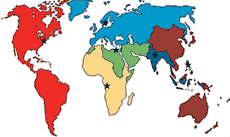


An aerosol is a collection of microscopic particles, solid or liquid, suspended in a gas.
In the context of air pollution, an aerosol refers to fine particulate matter, that is larger than a molecule, but small enough to remain suspended in the atmosphere for at least several hours.
The term aerosol is also commonly used for a pressurized container (aerosol can) which is designed to release a fine spray of a material such as paint. It has also come to be associated, erroneously, with the gas (propellant) used to expel materials from an aerosol can. (Source: GreenFacts )
Any one of a group of diseases that occur when cells in the body become abnormal and have the potential to spread and establish growth in nearby tissues and other parts of the body (malignancy). (Source: GreenFacts )
The system that contains the heart and the blood vessels and moves blood
throughout the body. This system helps
tissues get enough oxygen and nutrients, and
it helps them get rid of waste products. The lymph system, which connects with
the blood system, is often considered part of the circulatory system.
(Source:
NCI
Dictionary of cancer
terms![]()
Contact with (touching) the skin.
(Source:
ATSDR
Link to ATSDR Glossary of
Terms![]()
Particulate matter present in air is divided into different categories depending on the size of the particles (aerodynamic diameter).
Fine particles are airborne particles which are smaller than coarse particles. They have an aerodynamic diameter of 2.5 µm or less (PM2.5). The fine particles which are smaller than 0.1 µm are referred to as ultrafine particles (PM0.1).
Please note that ultrafine particles (PM0.1) are part of the fine fraction (PM2.5). (Source: GreenFacts)
The act of breathing.
A hazardous substance can enter the body by inhaling an airborne substance or contaminant in the form of gas, fumes mists, vapors, dusts, or aerosols. Once inhaled, contaminants can be deposited in the lungs and/or transported into the blood. (Source: GreenFacts)
A group of over 100 different organic compounds composed of several benzene rings. Some of them are persistent and carcinogenic.
PAHs are commonly formed during the incomplete burning of coal, oil and gas, garbage, or other organic substances like tobacco or charbroiled meat.
Generally, tobacco smoke is by far the most important source of exposure for humans. (Source: GreenFacts)
"The World Health Organization![]()
193 countries and two associate members are WHO’s membership. They meet every year at the World Health Assembly in Geneva to set policy for the Organization, approve the Organization’s budget, and every five years, to appoint the Director-General. Their work is supported by the 34-member Executive Board, which is elected by the Health Assembly. Six regional committees focus on health matters of a regional nature."
WHO's scientific publications are widely recognized as a reference source.
The WHO has a number of regional offices which address the specific issues of those regions.

| WHO African Region |
|
| WHO European Region |
|
| WHO Eastern Mediterranean Region |
|
| WHO Region of the Americas |
|
| WHO South-East Asia Region |
|
| WHO Western Pacific Region |

This summary is free and ad-free, as is all of our content. You can help us remain free and independant as well as to develop new ways to communicate science by becoming a Patron!